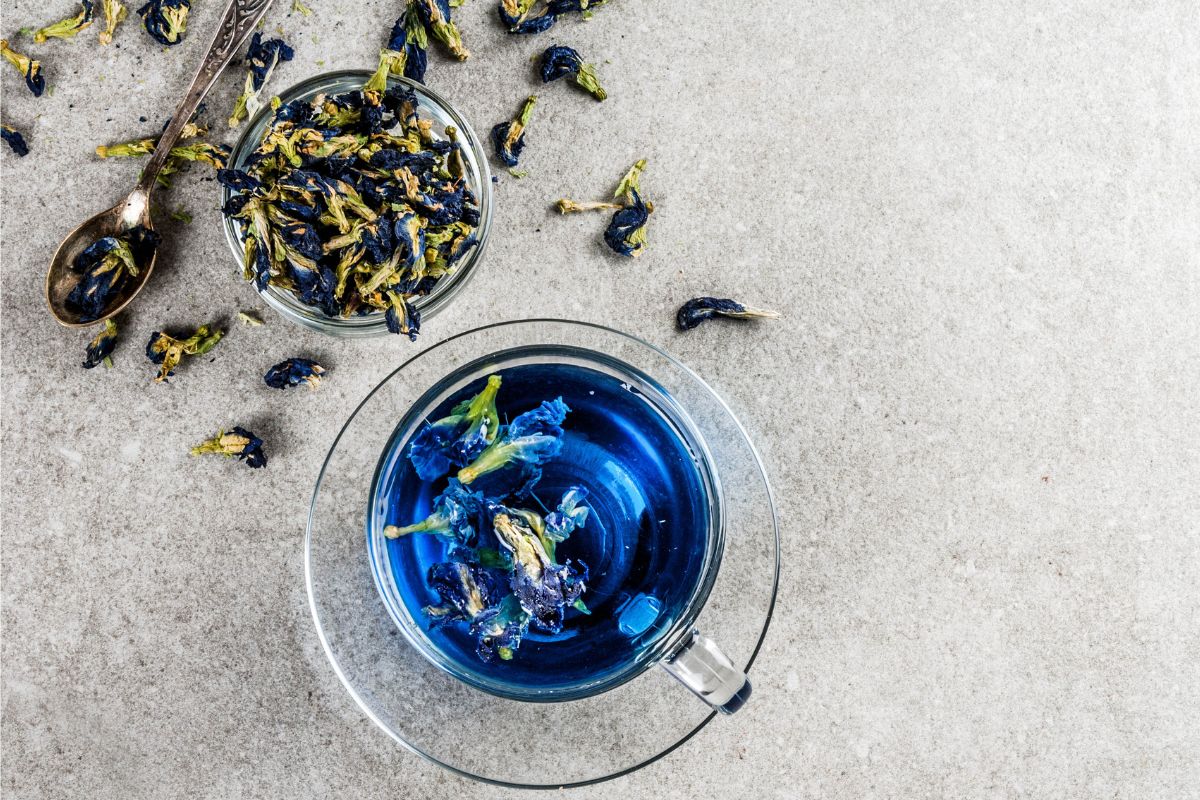Blue Lotus Flower Tea : Calming, Curious, and Kinda Magical

Some things don’t need a big introduction. The blue lotus flower is one of those. It’s been around for centuries, quietly showing up in old art, old stories, and quiet cups of tea.
These days, you’ll find it in tea blends, herbal drops, or even tucked into a warm bath. People like the calm it brings — not the “knock-you-out” kind, but a softer, slower kind of peace.
So if things feel heavy, or sleep doesn’t come easy, or you just want a natural way to feel more settled, the blue lotus flower might be worth a try.
Table of Contents
ToggleFirst, What Is It?
The blue lotus flower isn’t really a true lotus. It’s technically a type of water lily — Nymphaea caerulea, if you want the Latin. It grows in still water, mostly in Egypt and parts of Asia. The petals open wide during the day and tuck in at night. People have used it for centuries, not just because it looks nice, but because it’s been linked to relaxation, dreams, and even romance.
In ancient Egypt, it wasn’t just some background plant. The blue lotus was everywhere — painted in tombs, carved into temples, and even used during rituals. Some say it was used to help people connect spiritually. Others say it was part of their version of a party. Probably a bit of both.
Blue Lotus Flower Tea — How People Drink It Now
Let’s start with the easiest way to try it: blue lotus flower tea. You don’t need much. Just dried petals and hot water. Steep it like any herbal tea — around 5 to 10 minutes. It smells slightly sweet and floral, kind of like a mix between chamomile and something deeper. Taste-wise? Not strong, not bitter. Just soft.

Some people sip it at night to wind down. Others brew a cup when they’re feeling tense or overthinking things. You’ll find blue lotus flower tea in loose petals or in tea bags, depending on the brand. A few folks even make iced versions with a bit of honey or lemon.
And yeah, some herbal fans mix it with other calming plants like lavender or passionflower. But on its own, it holds up pretty well.
Blue Lotus Flower Benefits — What People Say It Helps With
Let’s be honest. There aren’t piles of modern studies on this flower. Most of what’s known comes from traditional use, online reviews, and people who just swear by it.
Still, some blue lotus flower benefits keep coming up again and again. Here’s what folks talk about:
Relaxation Without Feeling Heavy
People say the tea gives a floaty kind of calm. Not sleepy. Not drowsy. Just a gentle, peaceful feeling that settles the mind without switching it off. If anxiety’s buzzing in the background, it seems to help quiet that down.
Sleep Support
It’s not a knockout herb, but some find it helps ease them into rest. Sipping blue lotus flower tea an hour before bed might be enough to make the edges of a long day soften. Not everyone feels it right away, but those who do say it makes dreams a bit clearer too.
Mood Lifter
This one’s harder to explain. It’s not like a sugar high. More like a lightness that creeps in, especially if you’re stuck in a stress loop. Some describe it as a slight mood shift — a little easier to smile, breathe, and pause.
Possible Aphrodisiac Effects
Yep. Some claim the blue lotus flower has mild aphrodisiac qualities. It’s been tied to sensual energy in different cultures. Is it a placebo? Maybe. Is it real? You’d have to try for yourself.
Mild Body Ease
A few herbal fans say they feel tension melt away in their shoulders or jaw after sipping the tea. It’s not the kind of thing that knocks pain out cold. But for everyday stress in the body, it might help take the edge off.
How People Use It Beyond Tea
Not everyone sticks to tea. The blue lotus flower gets used in other ways too:
- Tinctures – These are drops made by soaking the flower in alcohol. People take a few drops under the tongue for a faster effect.
- Incense and Oils – Some use it in diffusers or as a calming scent during meditation.
- Soaks – A handful of petals in bath water? Smells amazing and adds that spa-like feel to the tub.
- Smoke Blends – Some mix dried petals with other herbs and smoke it. More niche, not for everyone.
Again, always check the quality if you’re buying it online. You want whole petals, not weird crushed stuff full of dust.
What It’s Not
Let’s keep it real here. The blue lotus flower is not medicine. It’s not going to “fix” your problems. It won’t erase sadness or knock out deep pain. It’s more of a gentle tool. A moment. A pause.
People who like it don’t say it changes everything. They say it makes things feel a little lighter, a little slower, and a little more manageable. And in today’s fast-everything world, that counts for something.
Any Risks?
It’s pretty gentle, but everyone’s different. Start slow. If you’re pregnant, breastfeeding, or taking medication, check with a doctor or herbalist. Don’t overdo it. Stick to normal amounts. Most people are fine with one cup of blue lotus flower tea a day.
And no, it won’t make you high. At least, not in the way people might expect. Some describe a dreamy quality — a floaty vibe — but it’s nothing wild.
Where To Get It
Most health food shops and herbal websites sell it. Just look for whole dried petals or reputable tea blends. Try small amounts first. Some versions are stronger than others.
A few solid options:
- Organic blue lotus flower tea from indie herbal brands
- Loose dried petals from trusted botanical sites
- Blends that include blue lotus with things like lavender or chamomile
Avoid cheap mixes with fillers or fake fragrance — if it smells like perfume, skip it.
Final Thoughts
The blue lotus flower isn’t about big changes or dramatic results. It’s more about small moments. A quiet breath before sleep. A soft shift in the middle of a hard day. A cup of tea that tastes like calm.
It’s not for everyone. Some won’t feel much. Others will swear it helped them through something. Either way, it’s simple, gentle, and easy to try.
No loud promises. Just petals, warm water, and a little peace.
Published by Amanda Mills
I'm Amanda Mills, Senior Content Strategist, and I've been shaping digital marketing narratives since 2011. With a master’s degree in Digital Marketing and a bachelor’s in Media Studies, I specialize in blending creative storytelling with data-driven strategy to create content that not only engages but delivers results. View more posts







